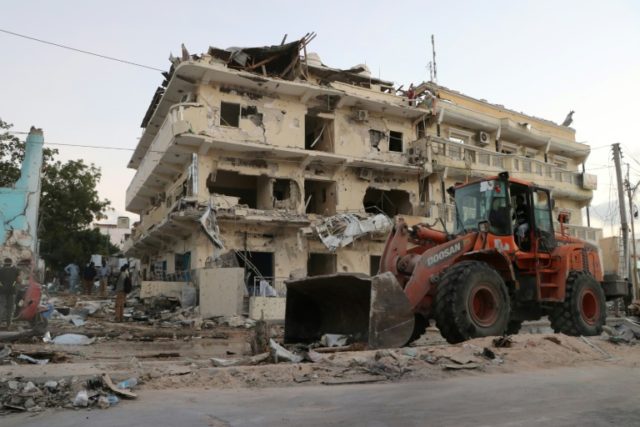The U.S. military steadily ramped up airstrikes against the Somalian terrorist group al-Shabaab over the past year, shifting its focus away from the dying Islamic State to al-Qaeda’s most feral ally with relatively little media attention.
The U.S. military announced on Monday that an airstrike on Sunday killed 35 al-Shabaab fighters, bring the total number of terrorists killed in 2019 to over 180. According to the U.S. Africa Command, the strike targeted al-Shabaab fighters as they were “transitioning between locations in a rural area” and inflicted no civilian casualties.
The battle against al-Shabaab was escalated slowly but constantly, rather than surging into a “shock and awe” campaign, so it has not been covered in the press as a major shift in American strategic focus.
The New York Times tallied up the numbers on Monday and noted U.S. officials are talking about the air campaign in Somalia as the one military intervention that definitely will not be scaled back over the coming year:
A surge in American airstrikes over the last four months of 2018 pushed the annual death toll of suspected al-Shabab fighters in Somalia to the third record high in three years. Last year, the strikes killed 326 people in 47 disclosed attacks, Defense Department data show.
And so far this year, the intensity is on a pace to eclipse the 2018 record. During January and February, the United States Africa Command reported killing 225 people in 24 strikes in Somalia. Double-digit death tolls are becoming routine, including a bloody five-day stretch in late February in which the military disclosed that it had killed 35, 20 and 26 people in three separate attacks.
Former National Security Council analyst Brittany Brown, now chief of staff for the International Crisis Group, told the NYT that American should pay more attention to the “massive war” developing largely on “autopilot” in Somalia, but another NSC veteran, Luke Hartig, offered the opposite analysis that U.S. commanders are trying to hit al-Shabaab hard and fast while they have the opportunity.
If Hartig’s take is correct, the U.S. is presumably hoping to wreck al-Shabaab’s infrastructure and degrade its manpower so that local allied forces can turn the tide against the terrorist group. Al-Shabaab is relatively small but vicious and nimble, and it prefers hit-and-run attacks such as the recent Mogadishu hotel massacre to Islamic State-style territorial conquest. The New York Times article quotes American commanders who reported success at goading al-Shabaab fighters into open combat by building outposts in their territory and then wiping out the attackers with heavy air support.
The Times noted President Donald Trump significantly escalated U.S. activities in Somalia, removing restrictions imposed by his predecessor President Barack Obama and authorizing U.S. commanders to order air strikes more quickly.
The Times article strives to portray the escalation as a war spiraling out of control with no clear strategic imperative, but details in the article such as the aforementioned outpost baiting strategy, deeper diplomatic engagement with the Somali government, and the growing strength of Somali security forces suggest a more coherent plan of action has been laid out, not just for Somalia but around the world as al-Qaeda eclipses ISIS as the major terrorist threat.
Foreign Policy last week quoted human rights activists who worried U.S. airstrikes are making the humanitarian crisis in Somali worse by driving people from their homes, although they could offer little in the way of evidence that American bombs are having a significantly more negative effect than the general violence between al-Shabaab forces, Somali government troops, and assorted peacekeepers. The one displaced Somali quoted in the article specifically stated she fled from her home due to fighting between al-Shabaab and government forces last summer, mentioning ten relatives were killed by “airstrikes” but providing no supporting details.
U.S. officials insist the airstrikes have targeted al-Shabaab positions with minimal collateral damage, and there have been few documented allegations to the contrary. The UK Guardian claimed in January 2018 that “dozens of civilians have been killed and wounded in Somalia as U.S.-led airstrikes against Islamist militants increase to unprecedented levels,” but the piece offers little evidence that most of these civilians were killed by American warplanes, only that American planes were “involved” in a few battles where civilian deaths were reported. Toward the end of the article, the Guardian noted that the United Nations blamed Kenyan forces for most of the confirmed civilian deaths in Somalia.
The Somali government accused the U.N. of interfering in its internal affairs in January because it felt the U.N. was excessively critical of civilian casualties incurred during Somali security operations against al-Shabaab. The U.N. reported heavy civilian casualties and widespread suffering in Somalia long before U.S. bombing began to increase, making it clear al-Shabaab is “the biggest threat to civilians” in the country, including both deliberate murders and collateral damage.

COMMENTS
Please let us know if you're having issues with commenting.